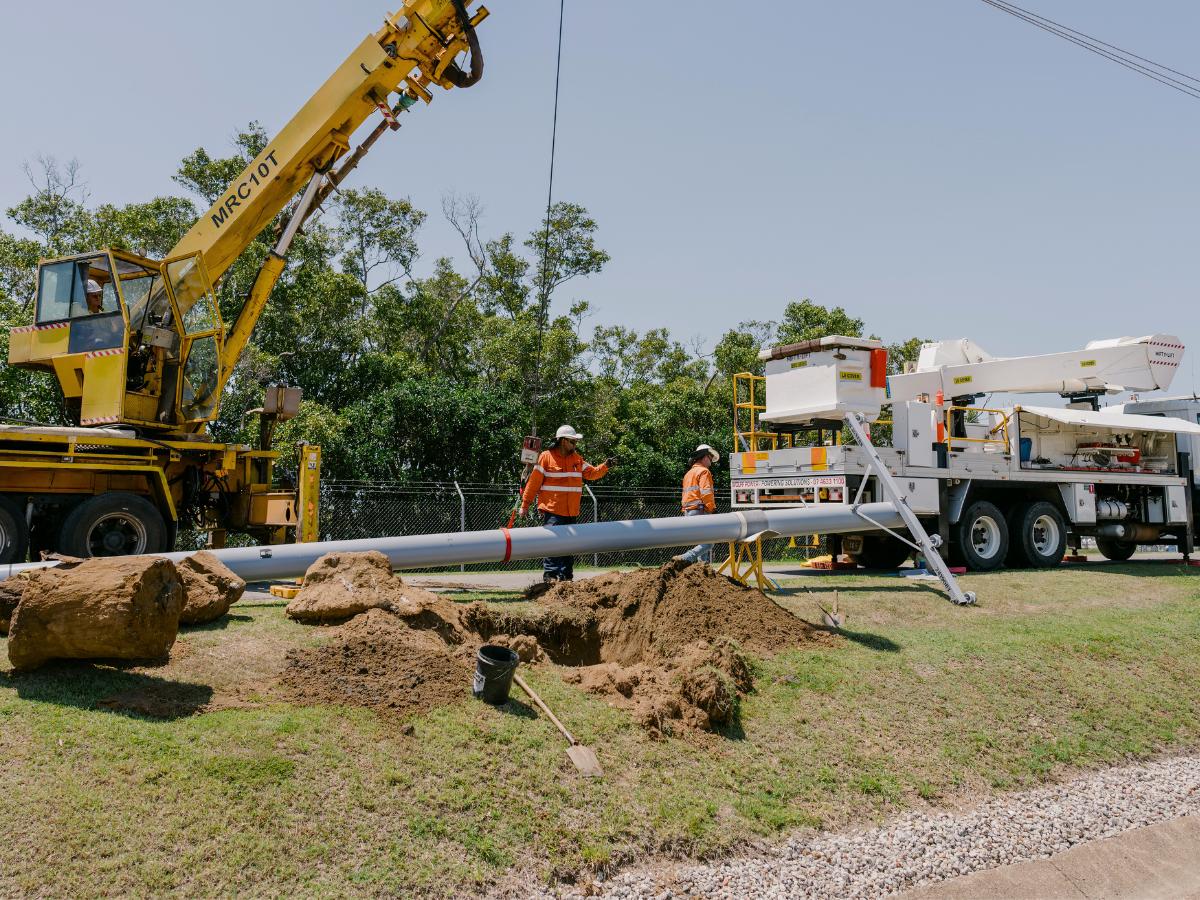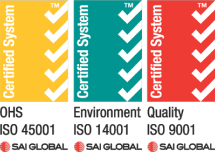Demand for Fibre Reinforced Polymer (FRP) utility poles is set to mirror the successful introduction and uptake of FRP crossarms set twenty years ago.
Currently, the global FRP crossarm market is expected to reach an estimated $147 billion by 2030*; and since 2003 Queensland based FRP crossarm business Wagners Composite Fibre Technologies (CFT) have manufactured more than 1.5 million crossarms largely for the Australian/New Zealand market.
It’s an uptake and trajectory that Wolff Power General Manager, Colin Dennis believes will be mirrored by FRP utility poles.
“When the Wagners composite fibre crossarms came out, everyone wanted them and the utility we were working for at that stage, only issued them to begin with, for certain locations. But then everyone only wanted to use the composite fibre arms,” Colin Dennis said.
“And I see that once people start using these poles, they’re going to be exactly the same. How easy they are to manage, how easy they are to construct. Everyone is going to be requesting composite poles, not a timber pole,” Mr Dennis said.
“So with a composite fibre pole, instead of having to use a cant hook and trying to work with all that weight, if you want to drill vertically, you can just grab the pole by your hand and rotate it and drill vertically, which gives you a lot straighter holes. But number two, it’s a lot easier on the body, reduces the risk of poles falling off pole stands. It’s just so much easier to fit,” he said.
“I think the beauty is that the poles don’t have imperfections. You know, they don’t have knots in the poles, they don’t have cracks in the poles. It is a manufactured product and you drill the hole where you want it, and that’s where it stays.”
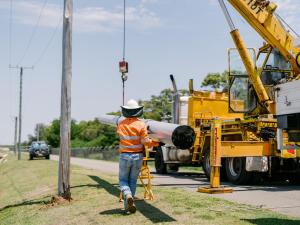 Pictured – Linesman preparing to remove an old timber pole that had reached the end of its serviceable life with a Wagners FRP utility pole.
Pictured – Linesman preparing to remove an old timber pole that had reached the end of its serviceable life with a Wagners FRP utility pole.
Fitting an FRP utility pole is very similar to traditional utility poles.
“So we fit all the hardware and on some poles that require earthing et cetera which we can do on FRP poles, no differently to a timber pole. So you make sure that, obviously all the earths are in place, all the bridges are pre fitted if you can. The next step is to remove the overhead conductors off the timber pole and try and pull the timber pole out,” Colin Dennis said.
“So once we’ve lifted the composite fibre pole into place, it’s exactly the same as a timber pole. We align the crossarm to take the conductors. The beauty again is it is so light. We don’t have to take weight with the crane to spin the pole to alignment,” Mr Dennis said.
“If it’s a 12 kilonewton pole, we can utilise the web sling or a webbing hook and turn it with one hand. There’s no pressure. The lightness and the construction of that pole allows you to maneuver it with one person without crane help,” he said.
“The webbing sling has been developed with a rubber grip on it where it contacts the pole. Obviously chains are used on timber poles; chains are heavy, they get hot, et cetera. These slings, because they’re specifically designed to work with FRP poles, they’re light, they’re clean, they don’t slip whether the composite pole is wet or not and they can be utilised as a cant hook if you need to spin the pole as well.”
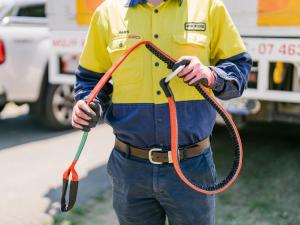 Pictured – Introduced to the Australian market by Wagners CFT, FRP utility pole webbing slings are clean, lightweight and will ensure the pole does not slip during installation.
Pictured – Introduced to the Australian market by Wagners CFT, FRP utility pole webbing slings are clean, lightweight and will ensure the pole does not slip during installation.
“So we align the crossarm and the hardware to where it’s got to go, and then we backfill it as per normal standards; so backfill to a hundred millimetres and compact with a hydraulic tamper, tampering it until the hole is full.”
“Once we’ve backfilled, obviously it’s reconnect all the conductors again, the pole itself; the functionality is exactly the same as a timber pole or a steel pole or a concrete pole, you reconnect exactly the same way as you would any other pole.”
“In the lines we’ve constructed using composite fibre poles it’s been as per normal practice, the only two things we have altered is number one the sling we lift with; and number two the drill bits we use.”
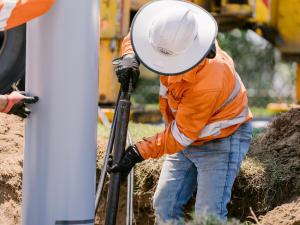 Pictured – Linesman backfilling and compacting hole.
Pictured – Linesman backfilling and compacting hole.
Reduced maintenance, improved installation outcomes and safety are all benefits of FRP utility poles.
“We’ve actually now started utilising the CFT poles on some of our sites because there’s minimal maintenance on them; we are not worried about water ingress, we are not worried about them splitting open,” Colin Dennis said.
“Network owners are using them so that in the future they don’t have to continue to replace them or they don’t have to continue to inspect them other than a visual inspection,” Mr Dennis said.
“Manual handling is one of the biggest risks in our job, especially when you’re working at heights. But when you start using composite fibre poles, that strain is gone; you can lift it pretty much with one hand and you have a lot more moveability,” he said.
“I think also when you transport them it is simpler; you don’t need heavy trucks, you don’t need to worry about overloading the front axle of a lifter borer because they’re so light they’re not going to overload your front axle. You’ll be able to carry more of them given a cradle to be able to put ’em in, which is a big bonus.”
“There’s so many timber poles that need to be replaced. And with the change of standards for conductor heights the availability of timber poles is not really there. You know, there’s plantation poles but can you you get it to the strength that you need to continue to build energy networks the way we do now? That’s the question for the market. But by using a manufactured product like the FRP poles then you’re guaranteed that you can get the strength pole that you need and the height pole that you need.
To watch a video featuring Colin Dennis visit https://www.youtube.com/watch?v=m78nNLNoqVw
For more information on Wagners CFT utility poles https://www.wagnerscft.com.au/solutions/electrical-infrastructures/utility-poles/
To download the Wagners CFT utility pole brochure https://www.wagnerscft.com.au/app/uploads/2024/05/wagners-cft-utility-pole-brochure.pdf
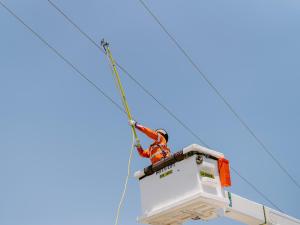 Pictured – Linesman preparing to remove a timber utility pole that has reached the end of its serviceable life by making safe lines.
Pictured – Linesman preparing to remove a timber utility pole that has reached the end of its serviceable life by making safe lines.
